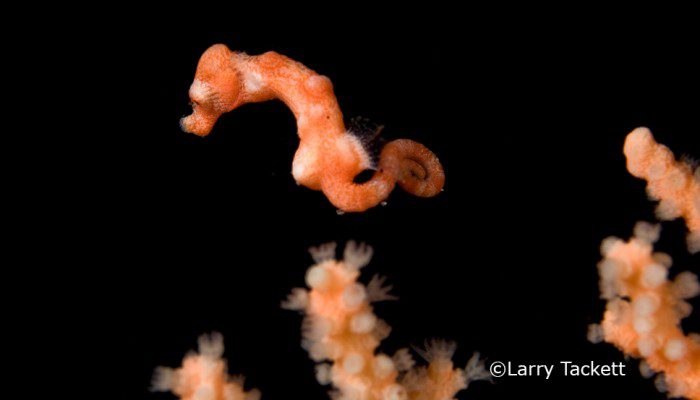Discovering the Denise Pygmy Seahorse
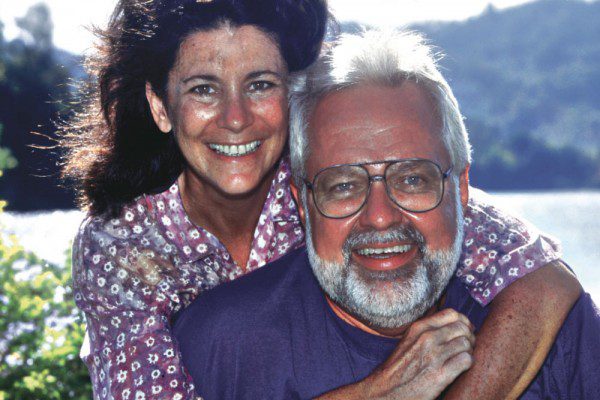
Paying Tribute to a Diver, a Photojournalist but most of all, an Inspiration
Here at Lembeh Resort we are among those who have been lucky enough to consider Denise Tackett a friend and to have been party to her great energy, dedication and love of the Lembeh Strait. It was with great sadness that we heard of her passing last year but here her husband Larry pays tribute to her and recalls his time with this amazing lady when diving in Lembeh was just being discovered. Denise and Larry who have dived and stayed with us at Lembeh Resort are true pioneers of Lembeh’s muck diving and we are proud to have been able to call Denise a friend:
It was twenty years ago that we first arrived in Lembeh Strait. We were working as research divers for the Cancer Research Institute of Arizona State University and had spent the previous ten years doing 3000 dives in some of the most amazing marine habitats imaginable. We had dived throughout the Indo-Pacific area, including Palau, Truk Lagoon, Papua New Guinea, Maldives, Seychelles, Comoros, Mauritius, Singapore, and Malaysia. We had left careers in engineering and banking to pursue an adventure that we thought would last 1-2 years, but here we were ten years later in this unknown place called Lembeh.
From the start Denise was fascinated by the marine life and understanding its behavior. In Indonesia we found ourselves in a new and different habitat, what would come to be known as muck diving. There was only one resort at this time and the diving world had not yet discovered it. Larry Smith was the dive master for the resort. There were not many reefs, but rather expanses of grayish black sand with bits of garbage on the bottom. But as we soon realized this was a very different place, for here in a relatively small body of water was the greatest congregation of rare and unusual marine life that we had ever seen. Virtually every dive turned up a new and different animal. Every dive provided an opportunity to observe and document marine life behavior.
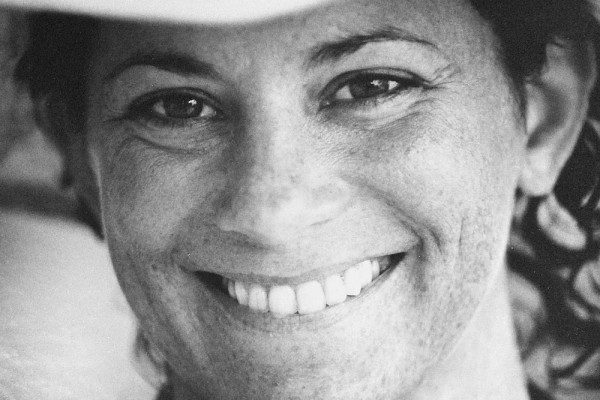 For the next year we collected specimens and photographs – lots of photographs of incredible marine life. After a year ASU wanted us to come home, as funding to continue the field research was getting difficult. We made a life changing decision and left the University to pursue our interests in marine life photojournalism. Denise wrote thirteen articles about Lembeh Strait in the first year for thirteen different magazines in as many countries. When we were in the US we were speaking at conferences and dive shows, spreading the word about the Lembeh Strait. We had become associated with the Lembeh Strait and muck diving. When we were not in the US we continued to spend time in Lembeh and were diving every day, devoting ourselves to photography and in Denise’s case the study of these amazing critters. She was truly in her element. She would spend countless hours watching and observing the small marine animals that were everywhere in great variety, and always taking copious notes about their behavioral attributes. It was this dedication to observing behavior that led to an amazing discovery.
For the next year we collected specimens and photographs – lots of photographs of incredible marine life. After a year ASU wanted us to come home, as funding to continue the field research was getting difficult. We made a life changing decision and left the University to pursue our interests in marine life photojournalism. Denise wrote thirteen articles about Lembeh Strait in the first year for thirteen different magazines in as many countries. When we were in the US we were speaking at conferences and dive shows, spreading the word about the Lembeh Strait. We had become associated with the Lembeh Strait and muck diving. When we were not in the US we continued to spend time in Lembeh and were diving every day, devoting ourselves to photography and in Denise’s case the study of these amazing critters. She was truly in her element. She would spend countless hours watching and observing the small marine animals that were everywhere in great variety, and always taking copious notes about their behavioral attributes. It was this dedication to observing behavior that led to an amazing discovery.
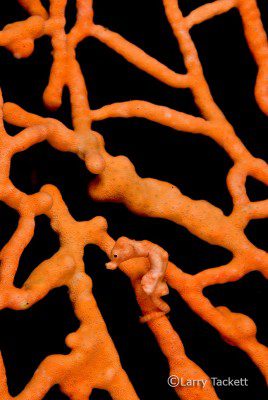 At that time there was only one known species of pygmy seahorse, Hippocampus bargibanti. It could be found on many sea fans in Lembeh Strait. It was typically red and white and lived on a particular species of sea fan. One day we saw an orange pygmy seahorse, very different in color from h. bargabanti. Denise sent pictures to seahorse experts and was told it was probably a color variant. After many hours of observing the orange pygmy she came to believe it was a different species. It was much more active that h. bargabanti and lived on a different species of sea fan. In 2003 Sara Lourie and Jack Randall wrote the scientific paper that described this new species, naming it in honor of Denise, Hippocampus denise, the dive industry and scientific community would come to call it Denise’s pygmy. This was the crowning moment of our two and a half years and 1500 dives in Lembeh Strait. But there would be more.
At that time there was only one known species of pygmy seahorse, Hippocampus bargibanti. It could be found on many sea fans in Lembeh Strait. It was typically red and white and lived on a particular species of sea fan. One day we saw an orange pygmy seahorse, very different in color from h. bargabanti. Denise sent pictures to seahorse experts and was told it was probably a color variant. After many hours of observing the orange pygmy she came to believe it was a different species. It was much more active that h. bargabanti and lived on a different species of sea fan. In 2003 Sara Lourie and Jack Randall wrote the scientific paper that described this new species, naming it in honor of Denise, Hippocampus denise, the dive industry and scientific community would come to call it Denise’s pygmy. This was the crowning moment of our two and a half years and 1500 dives in Lembeh Strait. But there would be more.
All those dives and observations led to the publication of Reef Life: A Natural History of Marine Fishes and Invertebrates, written solely by Denise, with both of us contributing images. Easily 90% of the images and behavioral observations described in the book were from Lembeh. No place had such an impact on us.
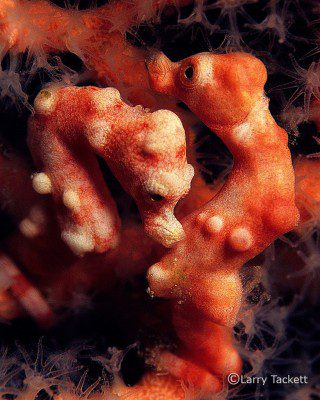
We went on to spend the next eight years diving, writing and photographing throughout the Indo-pacific region. Ironically, the last place we dived together was indeed Lembeh Strait. Denise’s ashes have even been scattered in the Lembeh Strait at her favorite dive spot. I am still adjusting to the quiet here at home following Denise’s passing. The inquisitive, loving, fun voice is gone and I will never be the same. That is what I will have to come to accept, if I ever can.
Recently I saw a quote that went something like this “Death ends a life, but never a relationship”. That to me was significant. Denise’s relationship with the critters of the ocean will go on through her writings and images. She will be forever associated with her pygmy seahorse.
